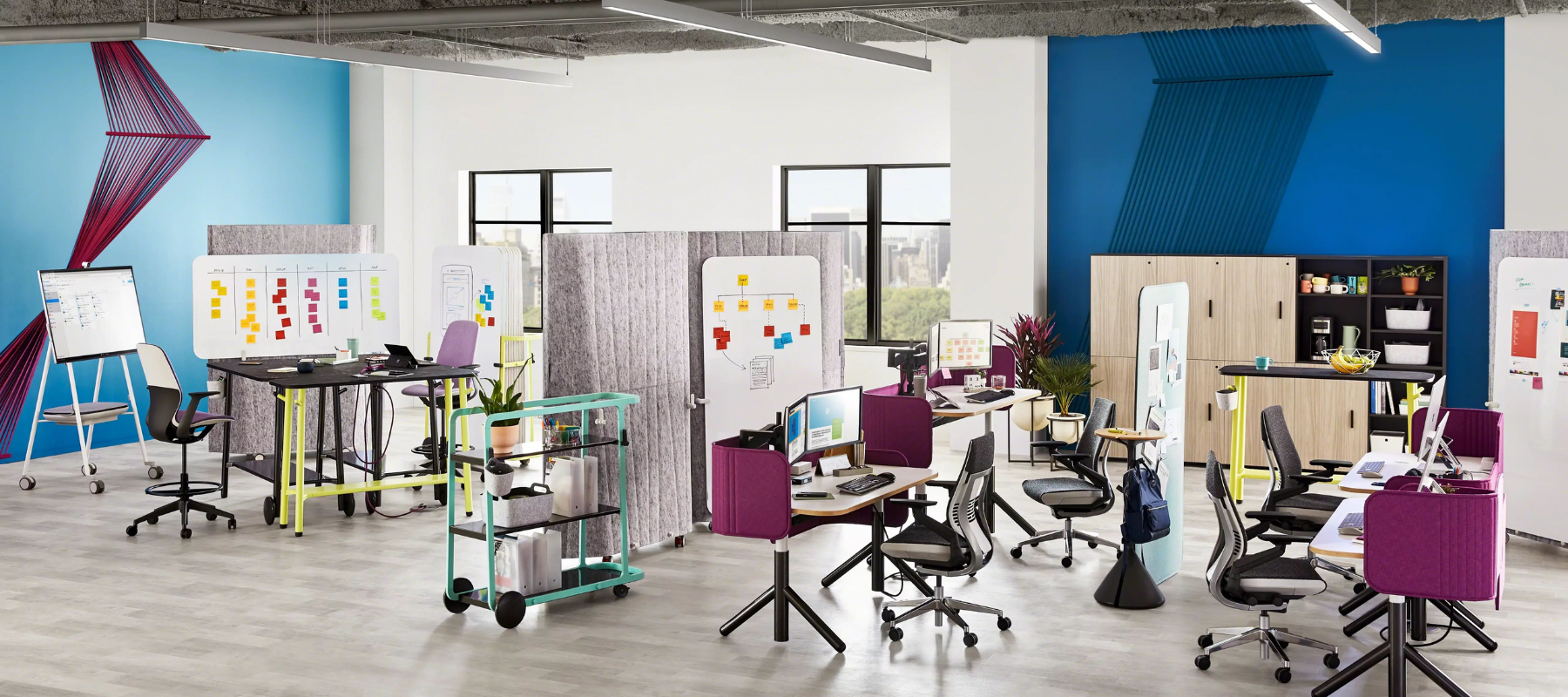The past few years have brought a lot of uncertainty to the world of work. The pandemic has forced us into a large working from home experiment, with varying levels of success. As organizations look to bring employees back to the office, they must be prepared to offer an ecosystem of spaces that allow employees more choice and control over how and where they work.
Building inherent flexibility into space planning is important. With so much uncertainty still abound, spaces must be designed with greater flexibility and mobility, allowing for quick adaption based on the needs of both individuals and teams.
From Fixed to Fluid: Steelcase Flex Collection

Creating flexible, adaptable spaces for teams has never been easier, thanks to solutions like the Steelcase Flex Collection. This collection offers organizations highly mobile and reconfigurable solutions that users can rearrange on demand to create environments that both teams and individuals need to do their best work. Dynamic team neighbourhoods designed for spontaneity empower teams to easily shift from a brainstorm to a workshop, or from a daily stand-up meeting to a spring review.
Mobile tables and acoustic screens allow teams to create impromptu meeting spaces without the need of permanent architecture changes or construction. And new releases such as Steelcase Flex Personal Spaces offer individuals a heightened level of privacy, control and comfort in the open plan office, while still supporting quick and easy adaptions to workstation orientation. Whether you need to take a video call at your desk or require sustained heads-down focus time, Personal Spaces gives more control and flexibility to your work experience while limiting exposure and reducing distractions – all while providing a comfortable place to work.
Designing Multimodal Spaces: Work Café

Over 50% of companies plan to pilot new spaces as part of their return to the office this year, and a company’s cafe is a good space to start experimenting. These spaces often sit empty parts of the day because they are typically used just for dining, individual work or small meetings. By looking at underutilized spaces in new ways, cafes can be redesigned as social hubs that will inspire people and provide high-performing settings where they can reconnect with their colleagues, as well as collaborate effectively.
Thinking about communal spaces like your break room or café as multimodal spaces offers employees further choice and control about where and how they work. They also create inspiring spaces beyond the desk where employees can go to rejuvenate and socialize with co-workers, something we’ve all been missing while working from home. Offering a variety of settings with different levels of privacy ensures that no matter the task, employees will be able to find a space to get work done. High performing spaces providing a mix of communal and individual experiences builds culture and trust in an organization, things that may have been lost while employees were working remotely.
Flexible Architectural Elements for the Hybrid Workplace

The productivity and effectiveness of the open office has been controversial even before the pandemic began, as complaints about noise and distractions dominated the debate. The rise of the hybrid workplace has rejuvenated this debate, with the rise of video calls and remote collaboration requires more private spaces with acoustic control. However, this doesn’t mean we have to go back to the cubicle farm and closed-door private offices.
Modular walls such as V.I.A. Wall by Steelcase create intelligent rooms without the need of traditional drywall construction. Intelligent rooms keep distributed teams aligned and connected, leveraging both analog and digital information to foster collaboration. V.I.A. elegantly hosts technology to create portals between physical and virtual worlds. V.I.A. can provide true acoustical privacy for collaborative teams, as well as for workers in adjacent work spaces, while achieving true acoustic privacy.
The rise in popularity of office pods and phone booths can also be attributed to the hybrid workplace trend. Office pods can provide locations in the open office for both individuals and small groups to focus and remotely collaborate while still maintaining the acoustic control necessary to focus.
More whimsical solutions like Steelcase Work Tents may not offer the same levels of acoustic controls that modular walls or office pods can, but rather they pair light and airy organic shapes with tent-like and sheer textiles to create a range of flexible and captivating privacy solutions. Lightweight and quickly deployable, Work Tents are easy to drop into any space giving people control to choose their desired amount of privacy. Reconfigurable by facilities managers as needed, they allow the workplace to easily adapt to changing conditions and needs.
As organizations begin to come together in new ways, the workplace will continue to evolve. Our team of workplace experts are here to help you create the best hybrid work experience. Contact us today!
